Crystallinity of Halogen-Free Flame-Retardant Polyolefin Compounds Loaded with Natural Magnesium Hydroxide
Abstract
1. Introduction
2. Materials and Methods
3. Results
3.1. Crystallization Behavior of C8-POE/LLDPE Blends
3.2. Crystallization Behavior of C8-POE/LLDPE/n-MDH Composites
3.3. Influence of n-MDH Content on Composites TC
3.4. Tensile Properties of C8-POE+LLDPE+n-MDH Composites
3.5. Fire Performance of the Highly Filled POE Compounds
4. Conclusions
Supplementary Materials
Author Contributions
Funding
Institutional Review Board Statement
Informed Consent Statement
Data Availability Statement
Acknowledgments
Conflicts of Interest
References
- Bar, M.; Alagirusamy, R.; Das, A. Flame retardant polymer composites. Fibers Polym. 2015, 16, 705–717. [Google Scholar] [CrossRef]
- Hu, Y.; Qian, X.; Song, L.; Lu, H. Polymer/Layered compound nanocomposites: A way to improve fire safety of polymeric materials. Fire Saf. Sci. 2014, 11, 66–82. [Google Scholar] [CrossRef]
- Kim, Y.; Lee, S.; Yoon, H. Fire-Safe polymer composites: Flame-retardant effect of nanofillers. Polymers 2021, 13, 540. [Google Scholar] [CrossRef] [PubMed]
- Nilsson, N.; Fischer, C.H.; Lassen, C.; Møller, C.; Brogaard, N.L. Fire Safety Requirements and Alternatives to Brominated Flame- Retardants. Minist. Environ. Food Den. 2016, 1822, 1–72. [Google Scholar]
- Konstantinova, A.; Yudaev, P.; Shapagin, A.; Panfilova, D.; Palamarchuk, A.; Chistyakov, E. Non-Flammable Epoxy Composition Based on Epoxy Resin DER-331 and 4-(β-Carboxyethenyl)phenoxy-phenoxycyclotriphosphazenes with Increased Adhesion to Metals. Sci 2024, 6, 30. [Google Scholar] [CrossRef]
- Li, Y.; Qi, L.; Liu, Y.; Qiao, J.; Wang, M.; Liu, X.; Li, S. Recent Advances in Halogen-Free Flame Retardants for Polyolefin Cable Sheath Materials. Polymers 2022, 14, 2876. [Google Scholar] [CrossRef]
- Sharma, V.; Agarwal, S.; Mathur, A.; Singhal, S.; Wadhwa, S. Advancements in nanomaterial based flame-retardants for polymers: A comprehensive overview. J. Ind. Eng. Chem. 2024, 133, 38–52. [Google Scholar] [CrossRef]
- Wei, M.; Murphy, D.; Barry, C.; Mead, J. Halogen-Free Flame Retardants for Wire and Cable Applications. Rubber Chem. Technol. 2010, 83, 282–302. [Google Scholar] [CrossRef]
- PINFA. Flame Retardants in Electric and Electronic. 2017. Available online: https://www.pinfa.eu/wp-content/uploads/2018/05/PINFA_EE_brochure_Edition_2017-11.pdf (accessed on 1 January 2022).
- Haveriku, S.; Meucci, M.; Badalassi, M.; Cardelli, C.; Pucci, A. Rheological and Aesthetical Properties of Polyolefin Composites for Flame Retardant Cables with High Loading of Mineral Fillers. Micro 2022, 2, 524–540. [Google Scholar] [CrossRef]
- Gupta, V.; Jain, D. Optimization of Halogen Free Flame Retardant Wire and Cable Compounds; Pluss Polymer: Bawal, India, 2007. [Google Scholar]
- Haveriku, S.; Meucci, M.; Badalassi, M.; Cardelli, C.; Ruggeri, G.; Pucci, A. Optimization of the Mechanical Properties of Polyolefin Composites Loaded with Mineral Fillers for Flame Retardant Cables. Micro 2021, 1, 102–119. [Google Scholar] [CrossRef]
- Prabhakar, M.N.; Shah, A.U.R.; Song, J.-I. A Review on the Flammability and Flame Retardant Properties of Natural Fibers and Polymer Matrix Based Composites. Compos. Res. 2015, 28, 29–39. [Google Scholar] [CrossRef]
- Hornsby, P.R. Fire retardant fillers for polymers. Int. Mater. Rev. 2001, 46, 199–210. [Google Scholar] [CrossRef]
- Rothon, R.N.; Hornsby, P.R. Flame retardant effects of magnesium hydroxide. Polym. Degrad. Stab. 1996, 54, 383–385. [Google Scholar] [CrossRef]
- Bamford, D.; Dlubek, G.; Lüpke, T.; Kilburn, D.; Stejnv, J.; Menke, T.J.; Alam, M.A. Free volume, glass transition and degree of branching in ethylene/α-olefin copolymers: Positron lifetime, differential scanning calorimetry, wide-angle X-ray scattering, and density studies. Macromol. Chem. Phys. 2006, 207, 492–502. [Google Scholar] [CrossRef]
- Quijada, R.; Dupont, J.; Miranda, M.S.L.; Scipioni, R.B.; Galland, G.B. Copolymerization of ethylene with 1-hexene and 1-octene: Correlation between type of catalyst and comonomer incorporated. Macromol. Chem. Phys. 1995, 196, 3991–4000. [Google Scholar] [CrossRef]
- Simanke, A.G.; Galland, G.B.; Freitas, L.; Da Jornada, J.A.H.; Quijada, R.; Mauler, R.S. Influence of the comonomer content on the thermal and dynamic mechanical properties of metallocene ethylene/1-octene copolymers. Polymer 1999, 40, 5489–5495. [Google Scholar] [CrossRef]
- Dow Chemical, Dow Wire and Cable. Cable Formulations ENGAGE Polyolefin Elastomers (POE) in Halogen Free Flame Retardant Cable Formulations; Dow Europe GmbH: Horgen, Switzerland, 2000. [Google Scholar]
- Camino, G.; Maffezzoli, A.; Braglia, M.; De Lazzaro, M.; Zammarano, M. Effect of hydroxides and hydroxycarbonate structure on fire retardant effectiveness and mechanical properties in ethylene-vinyl acetate copolymer. Polym. Degrad. Stab. 2001, 74, 457–464. [Google Scholar] [CrossRef]
- McGenity, P.M.; Hooper, J.J.; Paynter, C.D.; Riley, A.M.; Nutbeem, C.; Elton, N.J.; Adams, J.M. Nucleation and crystallization of polypropylene by mineral fillers: Relationship to impact strength. Polymer 1992, 33, 5215–5224. [Google Scholar] [CrossRef]
- Rothon, R.N. Particulate-Filled Polymer Composites, 2nd ed.; iSmithers Rapra Publishing: Shrewsbury, UK, 2003; Volume 554. [Google Scholar]
- Batistini, A. New polyolefin plastomers and elastomers made with insiteTM technology: Structure—Property relationship and benefits in flexible thermoplastic applications. Macromol. Symp. 1995, 100, 137–142. [Google Scholar] [CrossRef]
- Chum, P.S.; Swogger, K.W. Olefin polymer technologies-History and recent progress at the Dow Chemical Company. Prog. Polym. Sci. 2008, 33, 797–819. [Google Scholar] [CrossRef]
- Hsu, Y.C.; Truss, R.W.; Laycock, B.; Weir, M.P.; Nicholson, T.M.; Garvey, C.J.; Halley, P.J. The effect of comonomer concentration and distribution on the photo-oxidative degradation of linear low density polyethylene films. Polymer 2017, 119, 66–75. [Google Scholar] [CrossRef]
- ASTM D1238/ISO 1133; Standard Test Method for Melt Flow Rates of Thermoplastics by Extrusion Plastometer. ASTM International: West Conshohocken, PN, USA, 2013.
- Kalantar Mehrjerdi, A.; Åkesson, D.; Skrifvars, M. Influence of talc fillers on bimodal polyethylene composites for ground heat exchangers. J. Appl. Polym. Sci. 2020, 137, 49290. [Google Scholar] [CrossRef]
- ISO 37:2017; International Standard Tensile Stress-Strain Properties. ISO: Geneva, Switzerland, 2017.
- DIN 4102; Fire Behavior of Building Materials and Elements. Deutsches Institut für Normung (DIN): Berlin, Germany, 1998.
- Li, J.; Shanks, R.A.; Olley, R.H.; Greenway, G.R. Miscibility and isothermal crystallisation of polypropylene in polyethylene melts. Polymer 2001, 42, 7685–7694. [Google Scholar] [CrossRef]
- Dikobe, D.G.; Luyt, A.S. Comparative study of the morphology and properties of PP/LLDPE/wood powder and MAPP/ LLDPE/wood powder polymer blend composites. Express Polym. Lett. 2010, 4, 729–741. [Google Scholar] [CrossRef]
- Meucci, M.; Haveriku, S.; Badalassi, M.; Cardelli, C.; Ruggeri, G.; Pucci, A. Effect of Polyolefin Elastomers’ Characteristics and Natural Magnesium Hydroxide Content on the Properties of Halogen-Free Flame-Retardant Polyolefin Composites. Micro 2022, 2, 164–182. [Google Scholar] [CrossRef]
- Karrad, S.; Lopez Cuesta, J.M.; Crespy, A. Influence of a fine talc on the properties of composites with high density polyethylene and polyethylene/polystyrene blends. J. Mater. Sci. 1998, 33, 453–461. [Google Scholar] [CrossRef]
- Chen, X.; Yu, J.; Guo, S.; Luo, Z.; He, M. Effects of Magnesium Hydroxide and Its Surface Modification on Crystallization and Rheological Behaviors of Polypropylene. Polym. Compos. 2009, 30, 941–947. [Google Scholar] [CrossRef]
- Luyt, A.S.; Malik, S.S.; Gasmi, S.A.; Porfyris, A.; Andronopoulou, A.; Korres, D.; Vouyiouka, S.; Grosshauser, M.; Pfaendner, R.; Brüll, R. Halogen-free flame-retardant compounds. Thermal decomposition and flammability behavior for alternative polyethylene grades. Polymers 2019, 11, 1479. [Google Scholar] [CrossRef] [PubMed]
- Shan, C.L.P.; Soares, J.B.P.; Penlidis, A. Mechanical properties of ethylene/1-hexene copolymers with tailored short chain branching distributions. Polymer 2001, 43, 767–773. [Google Scholar] [CrossRef]
- EN 50399; Common Test Methods for Cables under Fire Conditions—Heat Release and Smoke Production Measurement on Cables during Flame Spread Test—Test Apparatus, Procedures, Results. CENELEC: Brussels, Belgium, 2022.
- Cardelli, A.; Ruggeri, G.; Calderisi, M.; Lednev, O.; Cardelli, C. Effects of poly(dimethylsiloxane) and inorganic fillers in halogen free flame retardant poly(ethylene-co-vinyl acetate) compound: A chemometric approach. Polym. Degrad. Stab. 2012, 97, 2536–2544. [Google Scholar] [CrossRef]
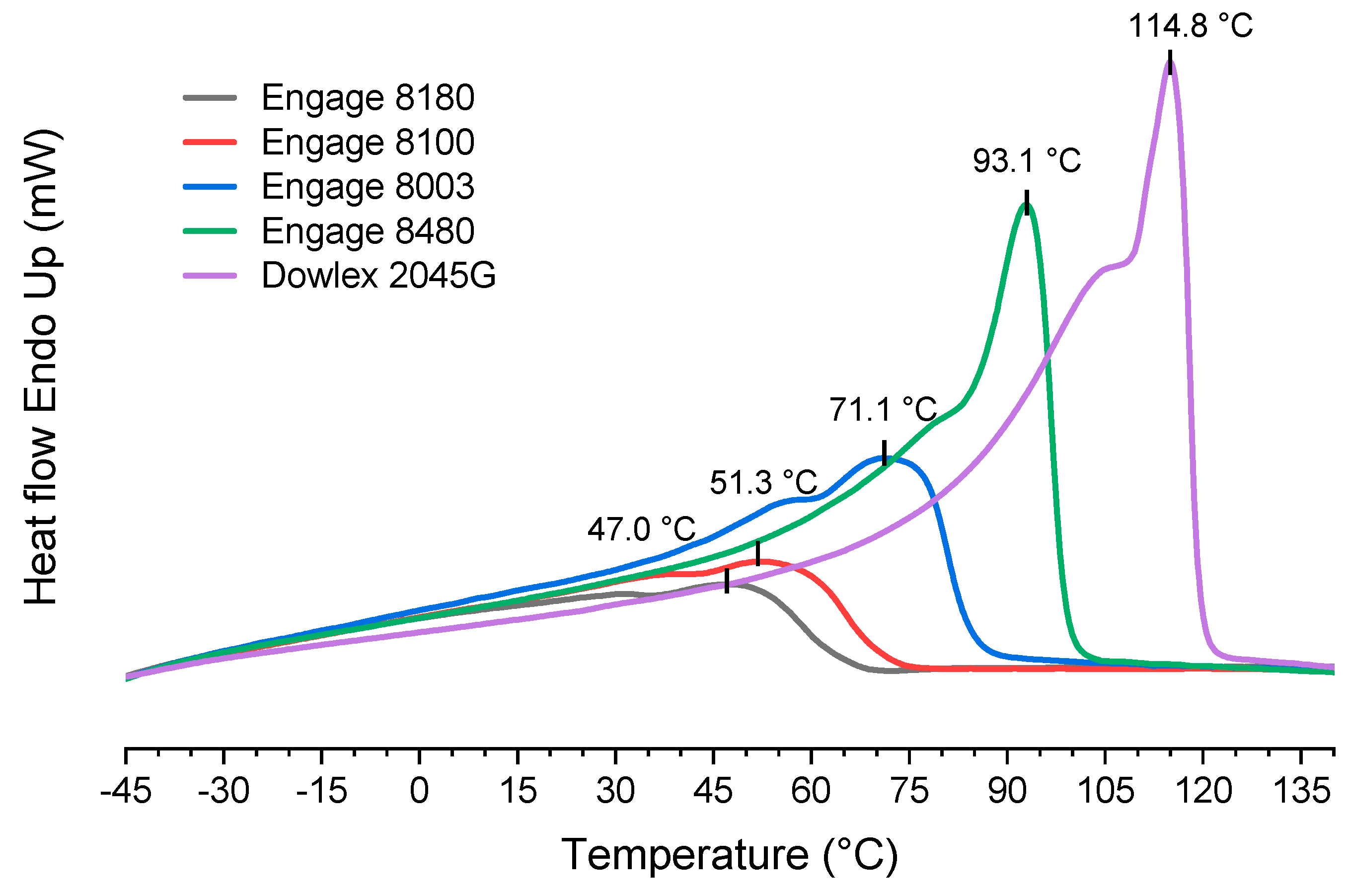
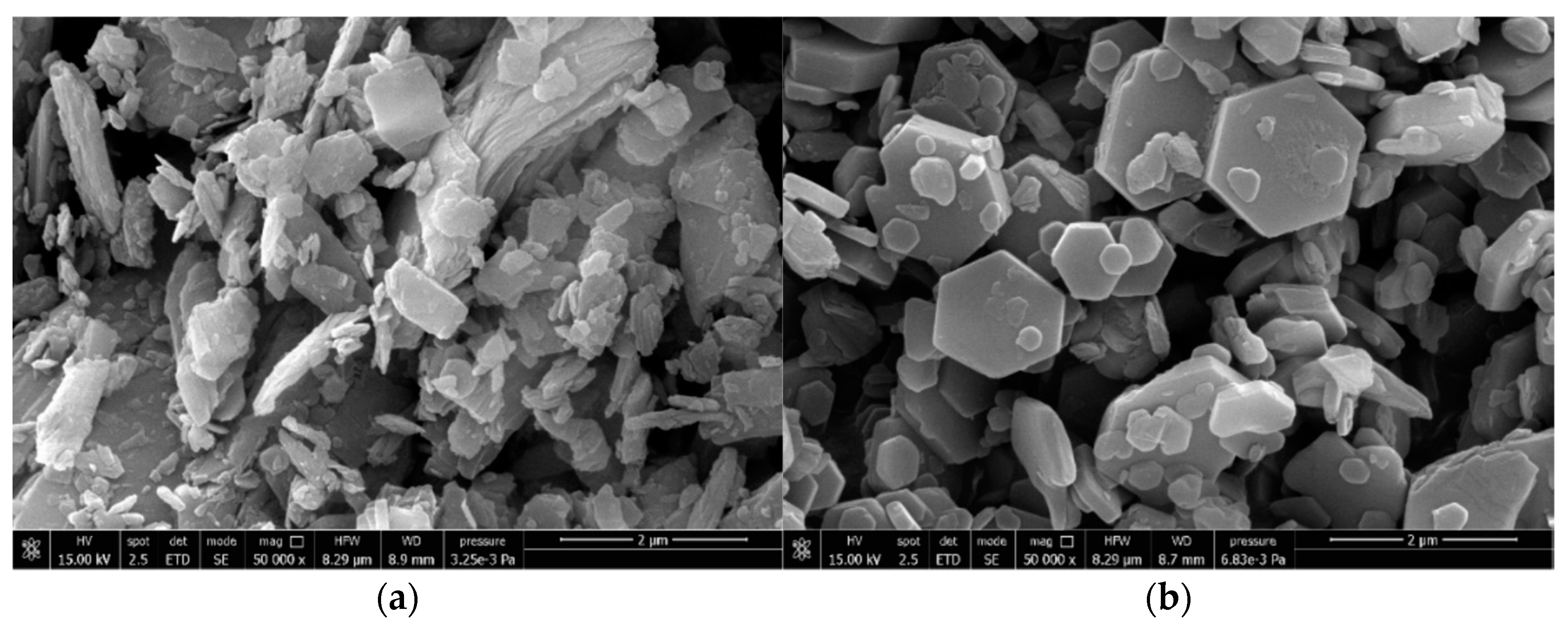
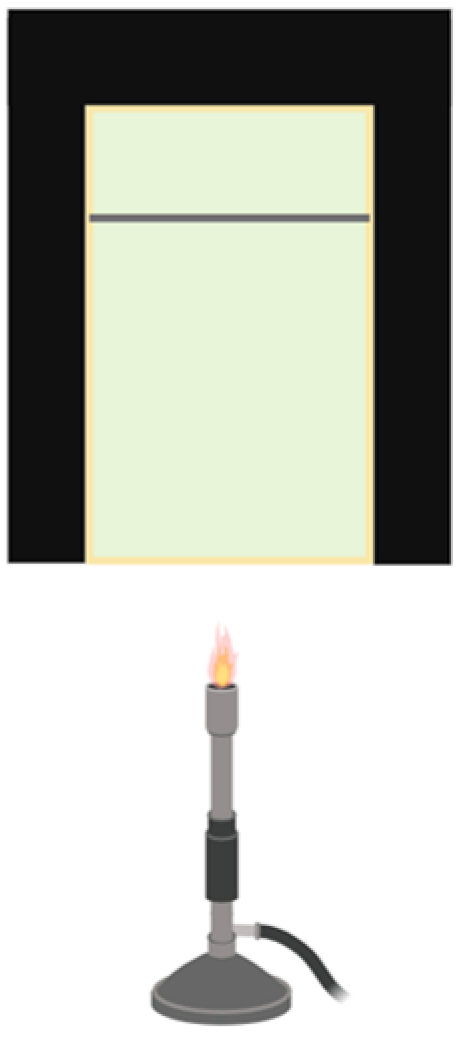
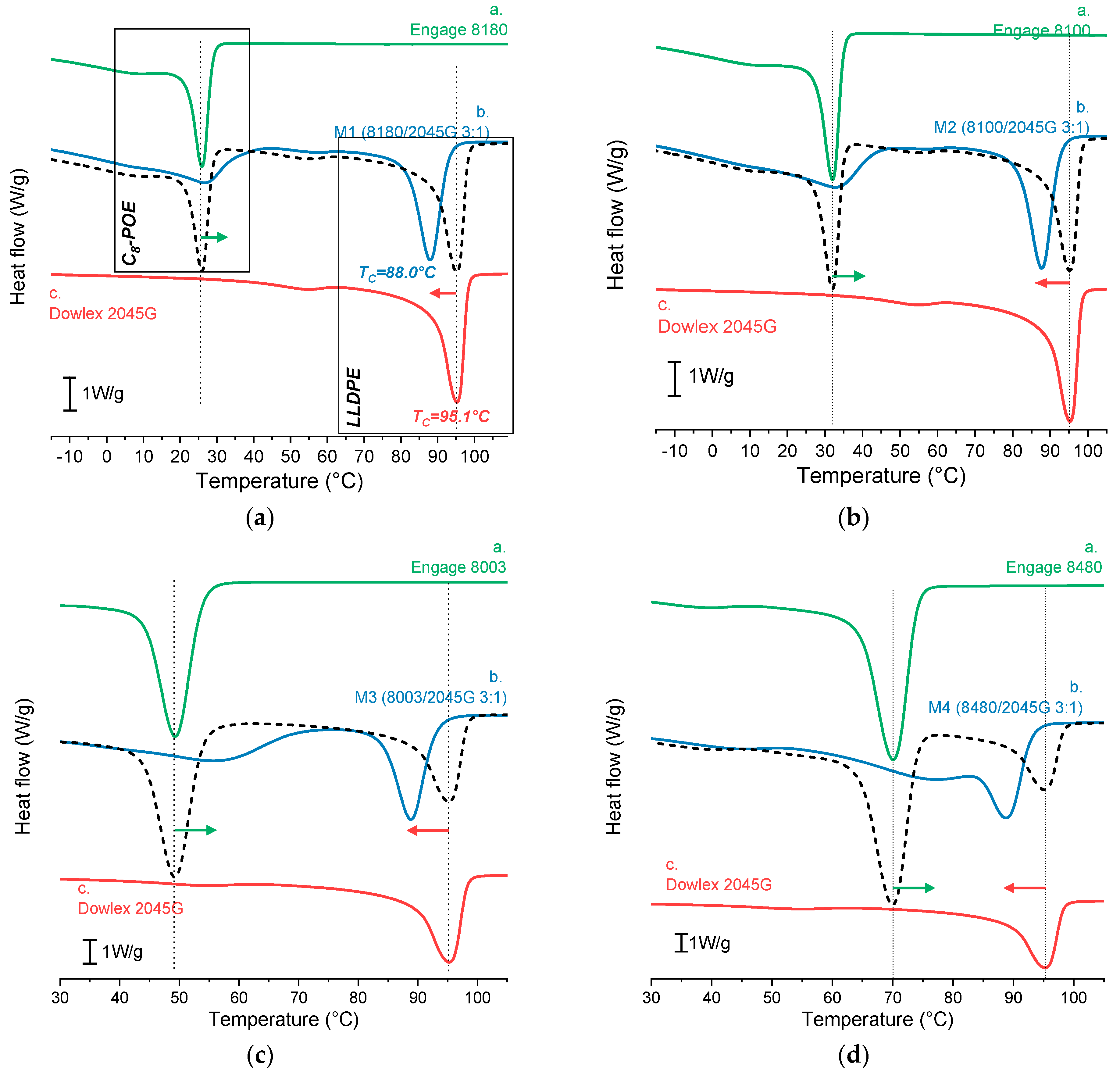
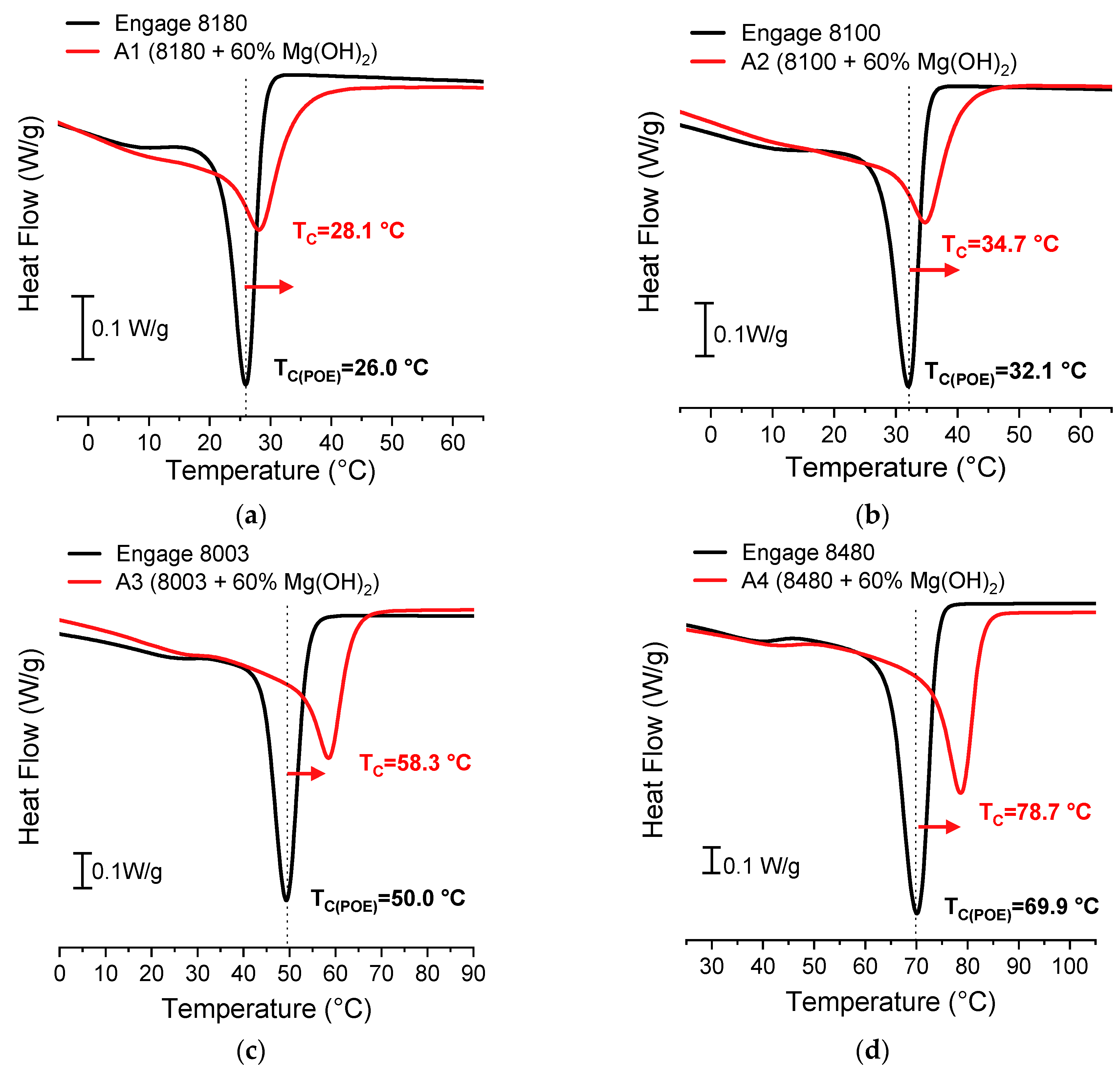

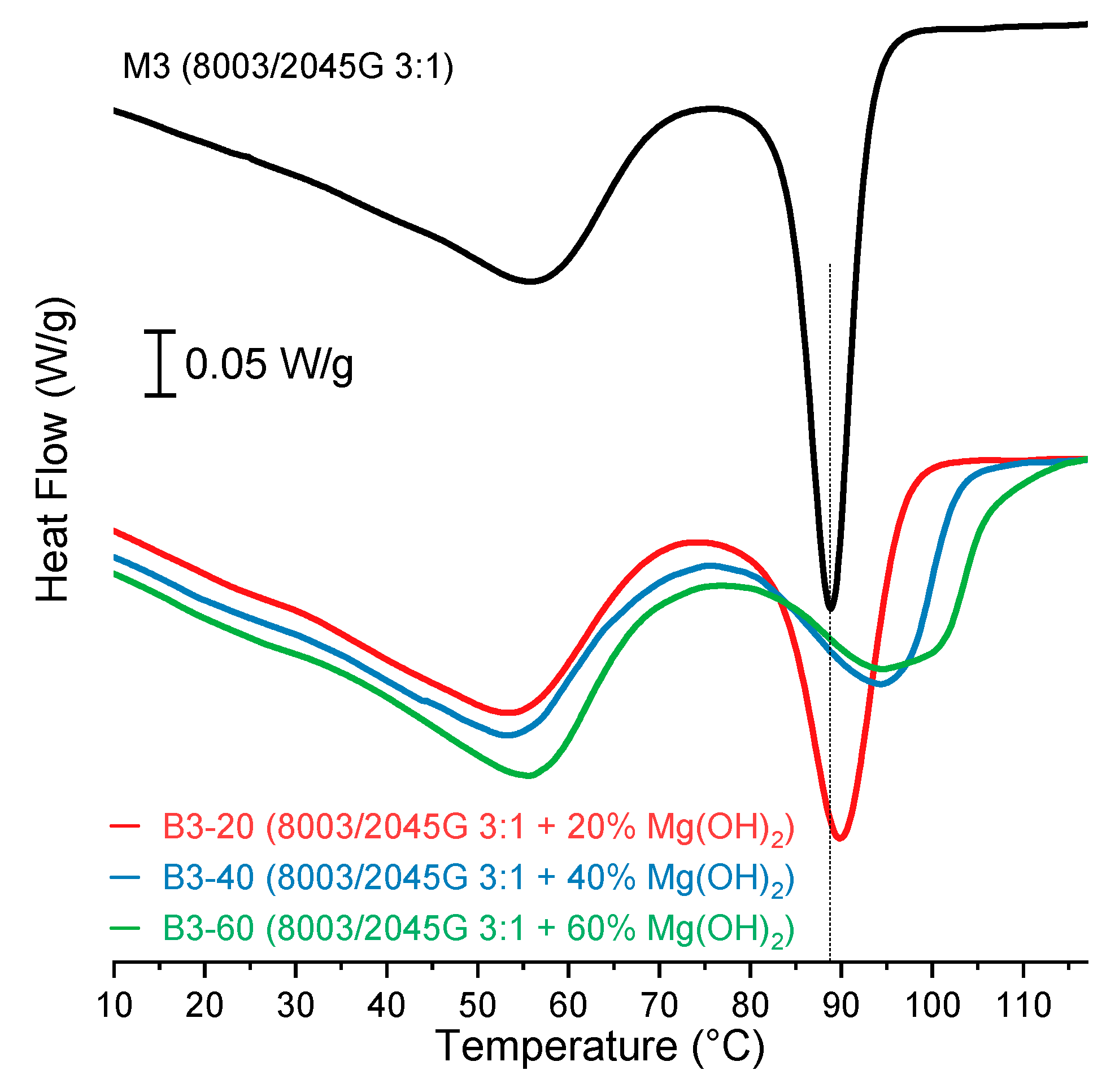
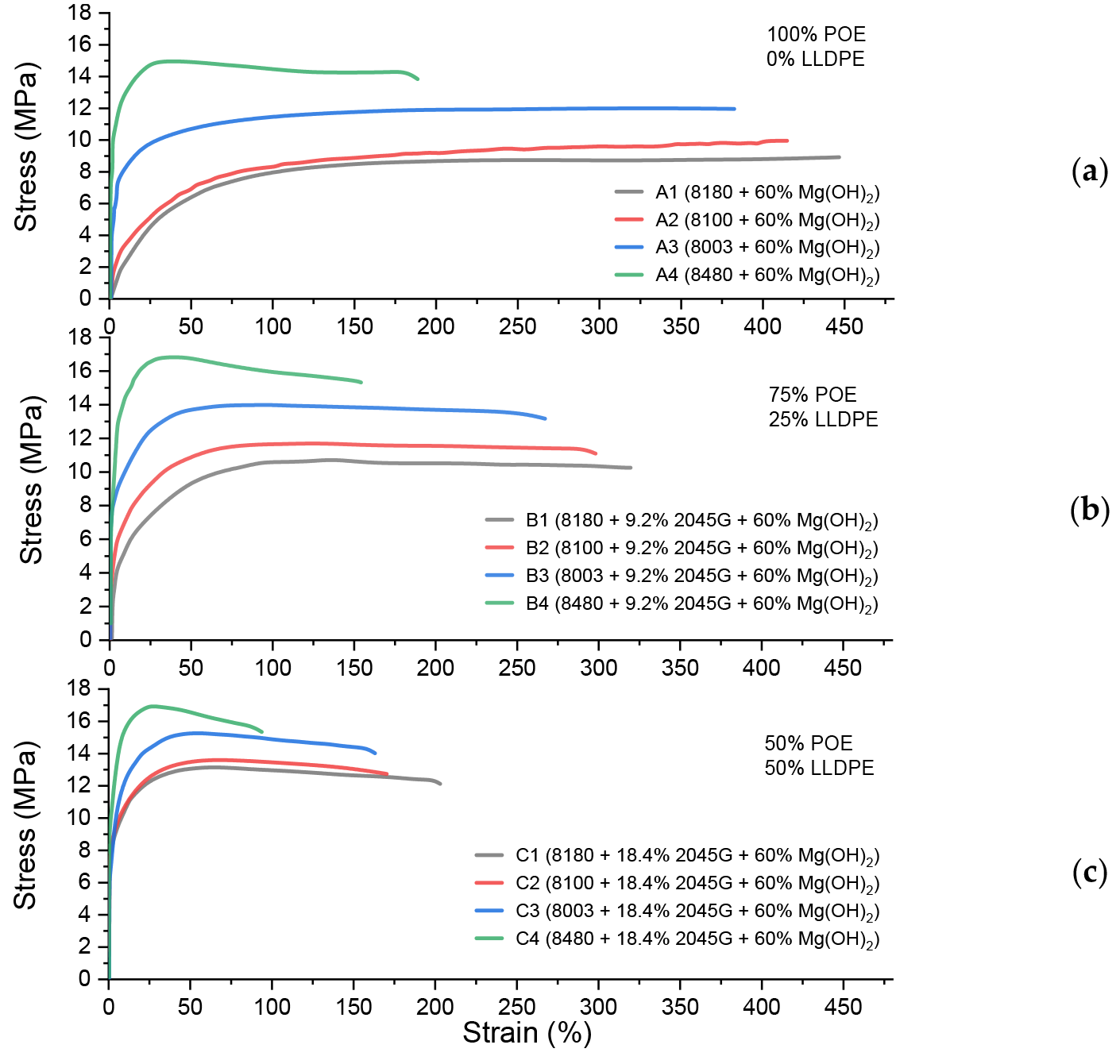
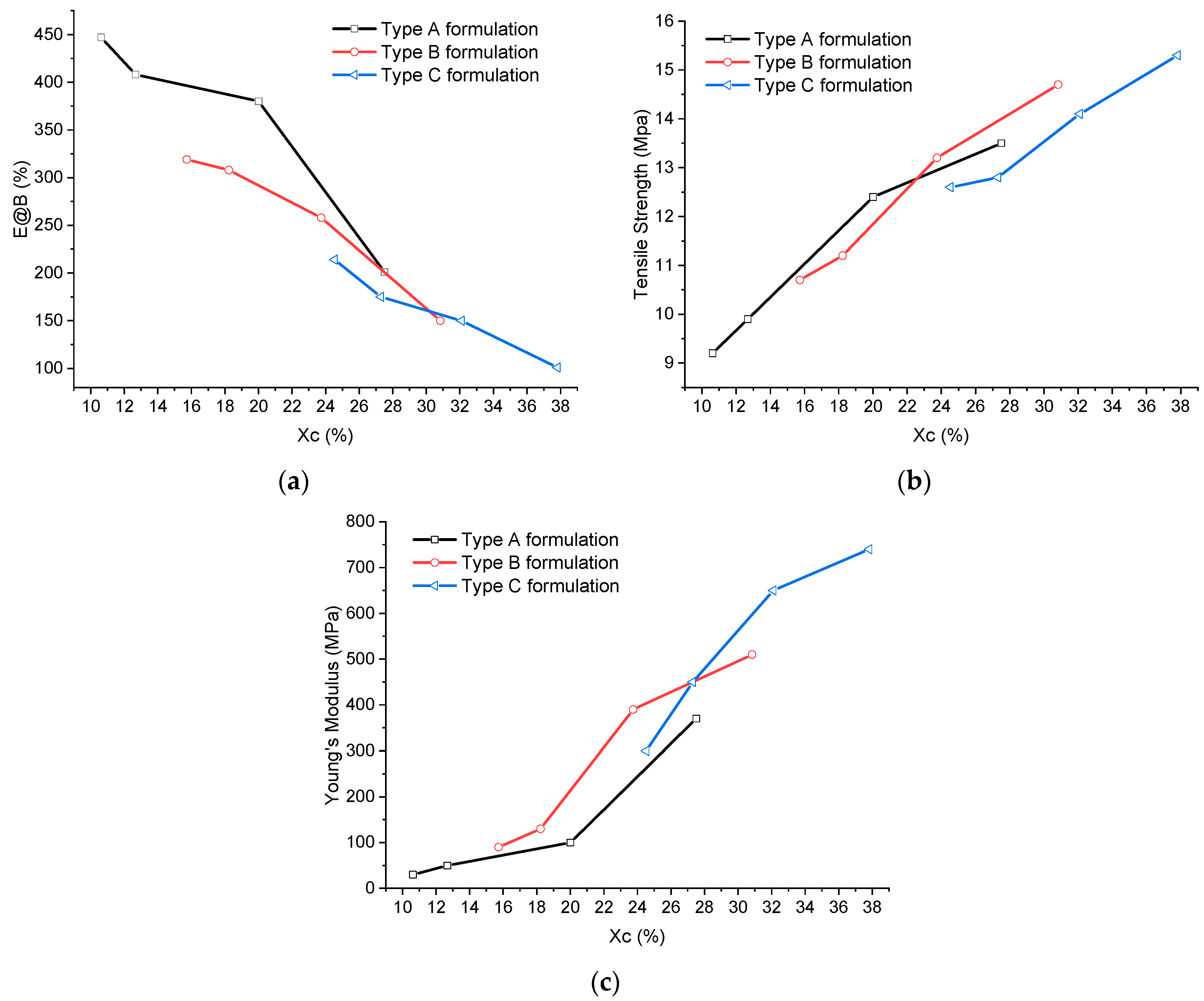

| Comonomer Content (wt.%) 1 | Density (g/cm³) 2 | XC (%) | Tm (°C) 3 | MFI (g/10 min) 4 | |
|---|---|---|---|---|---|
| Engage 8180 | 37.6 | 0.863 | 15.1 | 47.0 | 0.5 |
| Engage 8100 | 34.2 | 0.870 | 16.9 | 51.3 | 1.0 |
| Engage 8003 | 25.1 | 0.885 | 24.5 | 71.1 | 1.0 |
| Engage 8480 | 16.8 | 0.902 | 31.3 | 93.1 | 1.0 |
| Dowlex 2045G | 2.7 [25] | 0.920 | 45.5 | 114.8 | 1.0 |
| M1 | M2 | M3 | M4 | |
|---|---|---|---|---|
| Engage 8180 | 75 | |||
| Engage 8100 | 75 | |||
| Engage 8003 | 75 | |||
| Engage 8480 | 75 | |||
| Dowlex 2045G | 25 | 25 | 25 | 25 |
| Base Polymer | Blend | TC C8-POE (°C) | ΔTPOE (°C) | TC LLDPE (°C) | ΔTLLDPE (°C) |
|---|---|---|---|---|---|
| Engage 8180 | M1 | 26.7 | +0.8 | 88.0 | −7.1 |
| Calculated M1 | 25.9 | 95.1 | |||
| Engage 8100 | M2 | 33.5 | +1.4 | 87.8 | −7.3 |
| Calculated M1 | 32.1 | 95.1 | |||
| Engage 8003 | M3 | 55.8 | +6.6 | 88.4 | −6.7 |
| Calculated M1 | 49.2 | 95.1 | |||
| Engage 8480 | M4 | 77.6 | +7.6 | 88.0 | −7.1 |
| Calculated M1 | 70.0 | 95.1 |
| Base Polymer | Blend | ΔHC POE (J/g) | ΔHM −ΔHCALC POE (J/g) | ΔHC LLDPE (J/g) | ΔHM −ΔHCALC LLDPE (J/g) |
|---|---|---|---|---|---|
| Engage 8180 | M1 | 24.1 | −4.8 | 24.1 | −4.7 |
| calculated M1 | 28.9 | 28.8 | |||
| Engage 8100 | M2 | 30.4 | −2.2 | 25.9 | −2.9 |
| calculated M2 | 32.6 | 28.8 | |||
| Engage 8003 | M3 | 48.9 | −3.6 | 22.5 | −6.3 |
| calculated M3 | 52.5 | 28.8 | |||
| Engage 8480 | M4 | 68.3 | −3.8 | 22.6 | −6.2 |
| calculated M4 | 72.0 | 28.8 |
| A1 (%) | A2 (%) | A3 (%) | A4 (%) | B1 (%) | B2 (%) | B3 (%) | B4 (%) | C1 (%) | C2 (%) | C3 (%) | C4 (%) | |
|---|---|---|---|---|---|---|---|---|---|---|---|---|
| Engage 8180 | 36.8 | 27.6 | 18.4 | |||||||||
| Engage 8100 | 36.8 | 27.6 | 18.4 | |||||||||
| Engage 8003 | 36.8 | 27.6 | 18.4 | |||||||||
| Engage 8480 | 36.8 | 27.6 | 18.4 | |||||||||
| Dowlex 2045G | - | - | - | - | 9.2 | 9.2 | 9.2 | 9.2 | 18.4 | 18.4 | 18.4 | 18.4 |
| Fusabond N525 | 3 | 3 | 3 | 3 | 3 | 3 | 3 | 3 | 3 | 3 | 3 | 3 |
| Ecopiren 3.5 | 60 | 60 | 60 | 60 | 60 | 60 | 60 | 60 | 60 | 60 | 60 | 60 |
| Irganox 1010 | 0.2 | 0.2 | 0.2 | 0.2 | 0.2 | 0.2 | 0.2 | 0.2 | 0.2 | 0.2 | 0.2 | 0.2 |
| Properties | ||||||||||||
| Density (g/cm3) | 1.402 | 1.404 | 1.414 | 1.435 | 1.413 | 1.414 | 1.424 | 1.436 | 1.419 | 1.426 | 1.433 | 1.443 |
| MFI (g/10 min) 1 | 2.7 | 4.1 | 3.7 | 4.3 | 2.8 | 4.1 | 3.4 | 4.8 | 2.7 | 3.7 | 3.5 | 4.1 |
| Properties | Engage 8180 | A1 | Engage 8100 | A2 | Engage 8003 | A3 | Engage 8480 | A4 |
|---|---|---|---|---|---|---|---|---|
| TC (°C) | 26.0 | 28.1 | 32.1 | 34.7 | 50.0 | 58.3 | 69.9 | 78.7 |
| ΔT (°C) | +2.1 | +2.6 | +8.3 | +8.8 | ||||
| ΔH (J/g) 1 | 38.6 | 32.3 | 43.4 | 38.3 | 70.0 | 59.7 | 96.1 | 81.6 |
| ΔHA-ΔHPOE | −6.3 | −5.1 | −10.3 | −14.5 | ||||
| XC (%) | 10.6 | 12.7 | 20.0 | 27.5 | ||||
| Properties | Engage 8180 | M1 | B1 | Engage 8100 | M2 | B2 | Engage 8003 | M3 | B3 | Engage 8480 | M4 | B4 | LLDPE |
|---|---|---|---|---|---|---|---|---|---|---|---|---|---|
| TC (POE) (°C) | 25.9 | 26.7 | 27.0 | 32.1 | 33.5 | 34.0 | 49.2 | 55.8 | 55.9 | 70.0 | 77.6 | 79.8 | - |
| TM/B-TPOE | - | +0.8 | +1.1 | - | +1.4 | +1.9 | - | +6.6 | +6.7 | - | +7.6 | +9.8 | - |
| TC (LLDPE) (°C) | - | 88.0 | 97.0 | - | 87.8 | 96.9 | - | 88.4 | 97.1 | - | 88.0 | 98.7 | 95.1 |
| TM/B-TLLDPE | - | −7.1 | +1.9 | - | −7.3 | +1.8 | - | −6.7 | +2.0 | - | −7.1 | +3.6 | - |
| Properties | Engage 8180 | M1 | B1 | Engage 8100 | M2 | B2 | Engage 8003 | M3 | B3 | Engage 8480 | M4 | B4 | LLDPE |
|---|---|---|---|---|---|---|---|---|---|---|---|---|---|
| ΔHC (POE) (J/g) | 28.9 | 24.1 | 23.4 | 32.6 | 30.4 | 29.7 | 52.5 | 48.9 | 48.6 | 72.0 | 68.3 | 70.5 | - |
| ΔHM/B-ΔHPOE | - | −4.8 | −5.5 | - | −2.2 | −2.9 | - | −3.6 | −3.9 | - | −3.8 | −1.5 | - |
| ΔHC (LLDPE) (J/g) | - | 24.1 | 23.7 | - | 25.9 | 24.8 | - | 22.5 | 22.0 | - | 22.6 | 21.0 | 28.8 |
| ΔHM/B-ΔHLLDPE | - | −4.7 | −5.2 | - | −2.9 | −4.0 | - | −6.3 | −6.8 | - | −6.2 | −7.8 | - |
| XC (%) | 15.8 | 18.2 | 23.7 | 30.9 |
| B3-20 (%) | B3-40 (%) | B3-60 (%) | M3 (%) | |
|---|---|---|---|---|
| Engage 8003 | 57.6 | 42.6 | 36.8 | 75 |
| Dowlex 2045G | 19.2 | 14.2 | 9.2 | 25 |
| Fusabond N525 | 3 | 3 | 3 | - |
| Ecopiren 3.5 | 20 | 40 | 60 | - |
| Irganox 1010 | 0.2 | 0.2 | 0.2 | - |
| Properties | B3-20 (%) | B3-40 (%) | B3-60 (%) | M3 (%) | |
|---|---|---|---|---|---|
| TC (°C) | POE fraction | 54.2 | 53.9 | 55.9 | 55.8 |
| TB-TM | −1.6 | −1.9 | +0.1 | - | |
| ΔHC (J/g) | 46.2 | 47.1 | 48.6 | 48.9 | |
| ΔHB-ΔHM | −2.7 | −1.8 | −0.3 | - | |
| TC (°C) | LLDPE fraction | 89.8 | 94.3 | 97.1 | 88.4 |
| TB-TM | +1.4 | +5.9 | +8.7 | - | |
| ΔHC (J/g) | 20.2 | 19.8 | 22.0 | 22.5 | |
| ΔHB-ΔHM | −2.3 | −2.7 | −0.5 | - |
| Base Polymers | Composite | XC (%) | Tensile Strength (MPa) | Elong. @break (%) | Young’s mod. (MPa) |
|---|---|---|---|---|---|
| Engage 8180 | A1 (only C8-POE) | 10.6 | 9.2 ± 0.3 | 447 ± 36 | 30 |
| B1 (C8-POE:LLDPE 3:1) | 15.8 | 10.7 ± 0.5 | 319 ± 15 | 90 | |
| C1 (C8-POE:LLDPE 1:1) | 24.5 | 12.6 ± 0.3 | 214 ± 29 | 300 | |
| Engage 8100 | A2 (only C8-POE) | 12.7 | 9.9 ± 0.1 | 408 ± 16 | 50 |
| B2 (C8-POE:LLDPE 3:1) | 18.2 | 11.2 ± 0.5 | 308 ± 26 | 130 | |
| C2 (C8-POE:LLDPE 1:1) | 27.3 | 12.8 ± 0.2 | 175 ± 7 | 450 | |
| Engage 8003 | A3 (only C8-POE) | 20.2 | 12.4 ± 0.6 | 380 ± 43 | 100 |
| B3 (C8-POE:LLDPE 3:1) | 23.7 | 13.2 ± 0.3 | 258 ± 26 | 390 | |
| C3 (C8-POE:LLDPE 1:1) | 32.1 | 14.1 ± 0.4 | 150 ± 35 | 650 | |
| Engage 8480 | A4 (only C8-POE) | 26.3 | 13.5 ± 0.3 | 201 ± 31 | 370 |
| B4 (C8-POE:LLDPE 3:1) | 30.8 | 14.7 ± 0.3 | 150 ± 28 | 510 | |
| C4 (C8-POE:LLDPE 1:1) | 37.8 | 15.3 ± 0.4 | 101 ± 22 | 740 |
| Sample | t1 1 (s) | t2 2 (s) | Self Extinguish | tburning drops 3 (s) | Flame Height (cm) | Flame Width (cm) |
|---|---|---|---|---|---|---|
| A1 | 80 ± 4 | 128.5 ± 0.7 | NO | 54 ± 1 | 28.5 | 8.0 |
| A2 | 80 ± 9 | 131 ± 5 | NO | 58 ± 6 | 28.0 | 8.0 |
| A3 | 83 ± 3 | 164 ± 3 | NO | 79 ± 5 | 28.0 | 7.5 |
| A4 | 98 ± 7 | 175 ± 9 | NO | 99 ± 8 | 27.0 | 7.0 |
| B1 | 86 ± 3 | 144.5 ± 0.7 | NO | 79 ± 4 | 27.7 | 7.5 |
| B2 | 94.5 ± 5 | 148 ± 1 | NO | 86 ± 8 | 28.2 | 7.0 |
| B3 | 86 ± 3 | 150 ± 7 | NO | 87 ± 2 | 27.5 | 7.0 |
| B4 | 101 ± 11 | 169 ± 1 | NO | 103 ± 9 | 26.7 | 7.5 |
| C1 | 101.5 ± 2 | 164 ± 8 | NO | 84 ± 7 | 26.5 | 7.5 |
| C2 | 108 ± 6 | 166 ± 7 | NO | 101 ± 4 | 26.5 | 7.0 |
| C3 | 99.5 ± 8 | 169 ± 2 | NO | 54 ± 1 | 28.7 | 8.0 |
| C4 | 105 ± 7 | 200 ± 20 | NO | 58 ± 6 | 27.5 | 7.5 |
Disclaimer/Publisher’s Note: The statements, opinions and data contained in all publications are solely those of the individual author(s) and contributor(s) and not of MDPI and/or the editor(s). MDPI and/or the editor(s) disclaim responsibility for any injury to people or property resulting from any ideas, methods, instructions or products referred to in the content. |
© 2024 by the authors. Licensee MDPI, Basel, Switzerland. This article is an open access article distributed under the terms and conditions of the Creative Commons Attribution (CC BY) license (https://creativecommons.org/licenses/by/4.0/).
Share and Cite
Matteucci, V.; Meucci, M.; Haveriku, S.; Cardelli, C.; Pucci, A. Crystallinity of Halogen-Free Flame-Retardant Polyolefin Compounds Loaded with Natural Magnesium Hydroxide. Eng 2024, 5, 2050-2066. https://doi.org/10.3390/eng5030109
Matteucci V, Meucci M, Haveriku S, Cardelli C, Pucci A. Crystallinity of Halogen-Free Flame-Retardant Polyolefin Compounds Loaded with Natural Magnesium Hydroxide. Eng. 2024; 5(3):2050-2066. https://doi.org/10.3390/eng5030109
Chicago/Turabian StyleMatteucci, Vanessa, Michela Meucci, Sara Haveriku, Camillo Cardelli, and Andrea Pucci. 2024. "Crystallinity of Halogen-Free Flame-Retardant Polyolefin Compounds Loaded with Natural Magnesium Hydroxide" Eng 5, no. 3: 2050-2066. https://doi.org/10.3390/eng5030109
APA StyleMatteucci, V., Meucci, M., Haveriku, S., Cardelli, C., & Pucci, A. (2024). Crystallinity of Halogen-Free Flame-Retardant Polyolefin Compounds Loaded with Natural Magnesium Hydroxide. Eng, 5(3), 2050-2066. https://doi.org/10.3390/eng5030109








